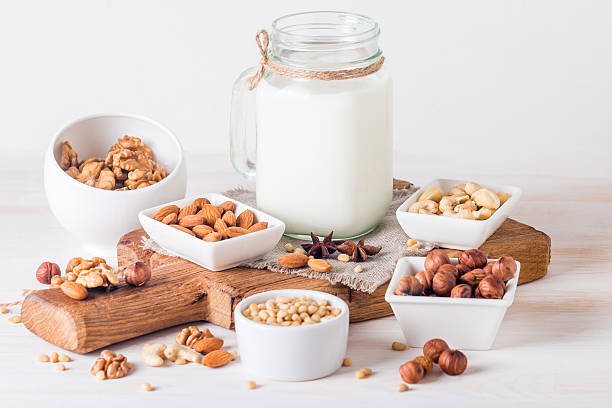
Nut milks are creamy, versatile, and a delicious dairy-free alternative for those looking to avoid animal products or reduce their environmental footprint. Making your own nut milk at home is easier than you might think, and it gives you full control over the flavor, consistency, and sweetness. Plus, it’s much more affordable and less wasteful than store-bought options! In this guide, we’ll walk you through how to make homemade almond, cashew, and oat milks, along with tips for straining, flavoring, and using them in your everyday recipes.
Why Make Nut Milk at Home?
Homemade nut milks are free from additives, preservatives, and artificial flavors that are often found in store-bought versions. You also have the flexibility to control how sweet or creamy your milk is. Whether you’re using it in smoothies, your morning coffee, or in baked goods, homemade nut milk is a much fresher, cleaner option than anything you can buy off the shelf. Plus, it’s super customizable, so you can experiment with flavors and textures to find your perfect milk!
1. Homemade Almond Milk
Almond milk is one of the most popular plant-based milks, known for its light and slightly nutty flavor. It’s great for smoothies, coffee, and even cereal.
Ingredients:
- 1 cup raw almonds
- 4 cups water
- 1-2 tbsp sweetener (optional, such as maple syrup, agave, or dates)
- 1 tsp vanilla extract (optional)
- A pinch of salt
Instructions:
- Soak the Almonds: Start by soaking the almonds in water for at least 12 hours or overnight. This softens the almonds and makes the blending process easier.
- Blend: Drain the almonds and place them in a high-speed blender with 4 cups of water. Blend on high for about 1-2 minutes until the almonds are fully broken down, and the mixture looks smooth and creamy.
- Strain: To strain the milk, you can use a nut milk bag, cheesecloth, or a fine mesh strainer. Place your strainer over a large bowl or pitcher and pour the almond milk through. Gently squeeze the nut milk bag or press down with a spoon to extract all the liquid.
- Flavor (Optional): If you’d like to add some sweetness, pour the milk back into the blender and blend in a little maple syrup, vanilla extract, or a pinch of salt.
- Store: Transfer the almond milk into a sealed glass jar or bottle and store it in the fridge for up to 4-5 days. Shake well before each use, as homemade nut milks tend to separate naturally.
2. Homemade Cashew Milk
Cashew milk is naturally rich and creamy, with a mild flavor that makes it ideal for lattes, smoothies, and baking. Unlike other nuts, cashews don’t require soaking before blending, which makes this recipe extra quick and easy!
Ingredients:
- 1 cup raw cashews
- 4 cups water
- 1-2 tbsp sweetener (optional, such as maple syrup or honey)
- 1 tsp vanilla extract (optional)
- A pinch of salt
Instructions:
- Blend: Place the raw cashews into a high-speed blender with 4 cups of water. Blend on high for 1-2 minutes until the milk is smooth and creamy. Unlike almond milk, there’s no need to soak cashews beforehand!
- Strain: Cashew milk is naturally smoother and doesn’t require as much straining, but you can still strain it through a nut milk bag or fine mesh strainer to remove any small cashew bits if you prefer a smoother texture.
- Flavor (Optional): Add sweetener, vanilla extract, and a pinch of salt to taste. Blend for a few more seconds until everything is fully combined.
- Store: Pour your cashew milk into a glass container and refrigerate. It’ll stay fresh for about 4-5 days. Shake before each use.
3. Homemade Oat Milk
Oat milk is the creamiest of the bunch, with a naturally sweet flavor that pairs beautifully in coffee, smoothies, and baked goods. It’s especially popular for use in lattes because it froths so well!
Ingredients:
- 1 cup rolled oats
- 4 cups water
- 1-2 tbsp sweetener (optional, such as maple syrup or dates)
- 1 tsp vanilla extract (optional)
- A pinch of salt
Instructions:
- Blend: Add the rolled oats and water to a blender and blend on high for about 30-45 seconds until the oats are broken down and the mixture looks smooth and creamy.
- Strain: To strain the oat milk, use a nut milk bag, cheesecloth, or a fine mesh strainer. Because oats can create a slightly thicker texture, you may need to press or squeeze a little harder to extract the liquid. Alternatively, you can skip straining for a thicker, more hearty milk, though some people prefer to strain out the oat pulp for a smoother texture.
- Flavor (Optional): Add sweetener and vanilla extract to taste, and blend again for a few seconds to combine.
- Store: Pour the oat milk into a jar or bottle and store it in the refrigerator for up to 4-5 days. Shake well before using.
Tips for Straining Nut Milk
- Nut Milk Bags: A nut milk bag is a reusable, fine mesh bag designed to strain nut milk. It’s the most efficient method for extracting liquid without losing too much milk. Just pour the mixture into the bag and gently squeeze.
- Fine Mesh Strainers: If you don’t have a nut milk bag, a fine mesh strainer will work well, though you may need to press down with a spoon to extract all the liquid. If you want the milk to be extra smooth, strain it twice.
- Cheesecloth: Another option is using cheesecloth, which can be folded over several times for finer filtration.
How to Flavor Homemade Nut Milks
Homemade nut milks are naturally quite neutral in flavor, but you can easily jazz them up with a few simple ingredients. Here are some flavoring ideas:
- Vanilla: Add 1 tsp of vanilla extract for a warm, sweet flavor. Perfect for adding to your morning coffee or pouring over granola.
- Cinnamon: A dash of cinnamon is great for giving your milk a cozy, spiced flavor—especially in oatmeal or chai lattes.
- Maple Syrup or Agave: For a touch of sweetness, add a tablespoon of maple syrup, agave, or honey to your milk. Blend it in with the rest of the ingredients.
- Cocoa: For chocolate milk, blend in a tablespoon or two of unsweetened cocoa powder, along with your sweetener of choice.
Uses for Homemade Nut Milk
Once you’ve made your homemade nut milk, it’s incredibly versatile and can be used in a wide range of recipes. Here are some of the most popular ways to incorporate it:
- Smoothies: Nut milk makes a creamy base for smoothies. Add fruits, greens, and protein powders to blend a delicious, nutrient-packed drink.
- Coffee and Lattes: Almond and oat milk are perfect for coffee drinks. Oat milk, in particular, creates the most luscious foam for lattes and cappuccinos.
- Baking: Substitute store-bought milk with homemade nut milk in your favorite muffin, pancake, or cake recipes. It can add extra creaminess to your baked goods, especially when using cashew or oat milk.
- Cereal: Pour your homemade milk over granola or oatmeal for a satisfying breakfast.
Final Thoughts
Making nut milks at home is an easy and rewarding process that allows you to create fresh, flavorful milk without the need for preservatives or additives. Whether you’re making almond, cashew, or oat milk, the recipes above will give you a creamy, dairy-free alternative that can be used in smoothies, coffee, baking, and beyond. Don’t be afraid to get creative with flavorings and experiment with different nuts and oats to find the perfect milk for your tastes. Plus, homemade nut milks are a great way to reduce waste and save money while enjoying the delicious taste of fresh, plant-based beverages. Happy blending!
